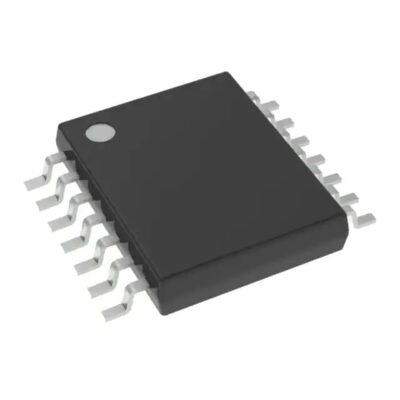SN74LVC125APWR
Part Number: SN74LVC125APWR
Manufacturer: Texas Instruments
Description: IC BUF NON-INVERT 3.6V 14TSSOP
Shipped from: Shenzhen/HK Warehouse
Stock Available: Check with us
ICRFQ.com - Electronic Components Distributor in China Since 2003

Part Number: SN74LVC125APWR
Manufacturer: Texas Instruments
Description: IC BUF NON-INVERT 3.6V 14TSSOP
Shipped from: Shenzhen/HK Warehouse
Stock Available: Check with us
| Datasheet | |
|---|---|
| Category | Integrated Circuits (ICs) |
| Family | Logic – Buffers, Drivers, Receivers, Transceivers |
| Manufacturer | Texas Instruments |
| Series | 74LVC |
| Packaging | Tape & Reel (TR) |
| Part Status | Active |
| Logic Type | Buffer, Non-Inverting |
| Number of Elements | 4 |
| Number of Bits per Element | 1 |
| Input Type | – |
| Output Type | Push-Pull |
| Current – Output High, Low | 24mA, 24mA |
| Voltage – Supply | 1.65 V ~ 3.6 V |
| Operating Temperature | -40°C ~ 125°C (TA) |
| Mounting Type | Surface Mount |
| Package / Case | 14-TSSOP (0.173″, 4.40mm Width) |
| Supplier Device Package | 14-TSSOP |
The SN74LVC125APWR is a buffer IC that is part of the SN74LVC family. It has high-speed operation, non-inverting buffering, a 4-element design, 3-state outputs, and outputs that don’t flip. This IC is very flexible and can be used in a wide range of computer applications.
The SN74LVC125APWR is a flexible and useful buffer IC because it has a number of features. The SN74LVC125APWR has the following key features:
Overall, the SN74LVC125APWR combines features like non-inverting buffering, a 4-element design, 3-state outputs, high-speed operation, low power usage, a Schmitt-trigger input, and a wide supply voltage range. Because of these things, it can be used for a wide range of electrical tasks and is reliable.
The SN74LVC125APWR is a quad buffer with 3-state outputs. Let’s dive into its functional operation, highlighting key components and their roles, as well as the behavior of the Output Enable (OE) pin and the input (A and B) and output (Y) connections of each buffer element.
Functional Operation: The SN74LVC125APWR consists of four independent buffer elements, labeled as Y1, Y2, Y3, and Y4. Each buffer element has two input pins, labeled A and B, and one output pin, labeled Y.
The buffer elements operate as follows
Output Enable (OE) Pin: The SN74LVC125APWR includes an Output Enable (OE) pin, which controls the behavior of the buffer outputs. When the OE pin is high (active), the buffer outputs (Y1 to Y4) are enabled and reflect the input data. In this state, the buffer elements actively buffer and propagate the input signals to the corresponding output pins.
When the OE pin is low (not active), on the other hand, the outputs of the buffer go into a high-impedance state. In this state, the bus or circuit that the buffer outputs are connected to is essentially cut off. In the high-impedance state, several devices can use the same output line without interfering with each other.
A and B are inputs, and Y is the result. Connections: In the SN74LVC125APWR, each buffer element has two input pins (A and B) and one output pin (Y). Standard digital logic is used to connect the inputs (A and B) of each buffer element to its outputs (Y).
For instance, the first buffer element’s (Y1) inputs (A1 and B1) are linked to its output pin (Y1). In the same way, the inputs A2 and B2 of the second buffer element (Y2) are linked to its output pin (Y2), and so on for the other buffer elements.
The input (A and B) and output (Y) links let the buffer elements receive the input signals, buffer them, and send out the buffered outputs. This lets the SN74LVC125APWR deal with multiple input signals and make the stored outputs that go with them.
By controlling the OE pin and connecting the input and output pins in the right way, the SN74LVC125APWR lets signals in different electrical systems be buffered in an efficient way.
Most of the time, the SN74LVC125APWR is used for the following:
The features of the SN74LVC125APWR make it possible to buffer signals in different electrical systems, meeting the needs of different industries.
The SN74LVC125APWR is commonly used in:
The SN74LVC125APWR finds applications in various electronic systems, providing effective signal buffering solutions for different industry needs.
The SN74LVC125APWR is a highly versatile and efficient integrated circuit (IC) known for its exceptional signal buffering capabilities. With features like non-inverting buffering, 4-element design, 3-state outputs, high-speed operation, low power consumption, and a wide supply voltage range, it offers a wide range of applications.
In summary, the SN74LVC125APWR is a reliable and versatile IC that provides efficient signal buffering solutions for diverse electronic applications. Its features make it invaluable in various industries. Contact us at ICRFQ for sourcing and further assistance.
WhatsApp us